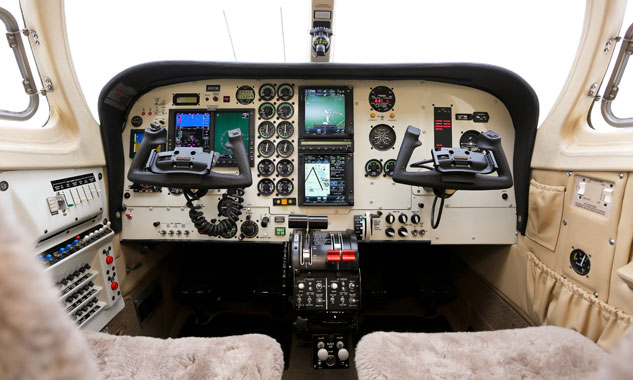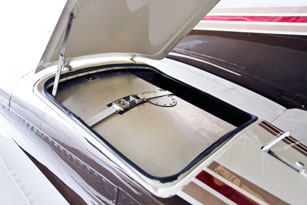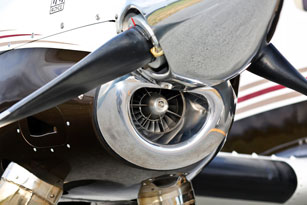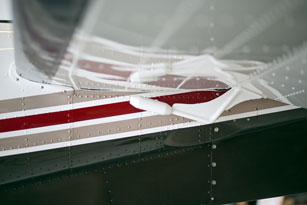Years ago David Dunkley of Logan, Utah, upgraded from O&N Aircraft Modifications’ Silver Eagle, a converted Cessna 210 with a 450-shaft-horsepower Rolls-Royce (Allison) 250-B17F/2 gas turbine engine and other enhancements, to a Pilatus PC–12NG. Now he has sold his 260-KTAS single-engine turboprop and gets 225 to 232 KTAS from O&N’s new turboprop conversion of the pressurized Cessna 340—and a much lower fuel bill.
Obviously it wasn’t speed that motivated the transaction. That second engine brings peace of mind. He operates from Logan-Cache Airport with its 4,500-foot elevation, and needs to maintain 14,000 feet on most of his trips just to keep above terrain. Before purchasing it, he confirmed on a demonstration flight that the Silver Eagle 340 will climb to 17,500 feet on one engine at maximum gross weight (cruising at 176 KTAS), and maintain altitude at 21,000 feet (cruising at 146 KTAS).

SPEC SHEET
Cessna 340 Silver Eagle
Base conversion price: $1.6 million
price as tested: $1.785 million
Specifications
Powerplants | (2) 400-shp Rolls-Royce 250-B17F/2
Recommended TBO | 3,500 hr (hot section 1,750 hr)
Propellers | Hartzell HC-B3TF-7A, 3 blade, 85 in dia
Length | 34 ft 2 in
Height | 12 ft 7 in
Wingspan | 38 ft 1 in
Wing area | 184 sq ft
Wing loading | 34.18 lb/sq ft
Seats | six plus two crew
Cabin length | 12 ft 7 in
Cabin width | 4 ft 3 in
Cabin height | 4 ft 1 in
Empty weight, as tested | 4,150 lb
Max ramp weight | 6,325 lb
Max gross weight | 6,290 lb
Useful load | 2,040 lb
Useful load, as tested | 2,140 lb
Payload w/full fuel (254 gal) | 352 l
Payload w/full fuel (254 gal), as tested | 452 lb
Max takeoff weight | 6,290 lb
Max landing weight | 5,990 lb
Zero fuel weight | 5,630 lb
Fuel capacity, std | 102 gal (100 gal usable), 683 lb (670 lb usable)
Fuel capacity, w/opt tanks | 254 gal (252 gal usable), 1,702 lb (1,688 lb usable)
Baggage capacity | 690 lb, 34 cu ft
Performance
Takeoff distance, ground roll | estimated 700 ft
Takeoff distance over 50-ft obstacle | estimated 1,000 ft
Accelerate-stop distance | 3,362 ft
Accelerate-go distance | 2,921 ft
Max demonstrated crosswind component | 23 kt
Rate of climb, sea level | 3,250 fpm
Single-engine ROC, sea level | 950 fpm
Cruise speed/endurance w/45-min rsv, std fuel (fuel consumption, ea engine) @ max cruise power | 237 kt/ 5.1 hr, 20,000 ft (168 pph/25 gph)
Max operating altitude | 25,000 ft
Service ceiling | 30,000 ft
Single-engine service ceiling | 17,500 ft
Absolute ceiling | 30,000 ft
Landing distance over 50-ft obstacle (reverse prop) | 1,500 ft
Landing distance, ground roll (reverse prop) | 1,000 ft
Limiting and Recommended Airspeeds
VMC (min control w/critical engine inoperative) | 85 KIAS
VSSE (min intentional one-engine operation) | 140 KIAS
VX (best angle of climb) | 105 KIAS
VY (best rate of climb) | 130 KIAS
VXSE (best single-engine angle of climb) | 110 KIAS
VYSE (best single-engine rate of climb) | 120 KIAS
VA (design maneuvering) | 155 KIAS
VFE (max flap extended) | 142 KIAS
VLE (max gear extended) | 140 KIAS
VLO (max gear operating)
Extend | 140 KIAS
Retract | 140 KIAS
VNO (max structural cruising) | 200 KIAS
VNE (never exceed) | 234 KIAS
VR (rotation) | 89 KIAS
VS1 (stall, clean) | 77 KIAS
VSO (stall, in landing configuration) | 71 KIAS
For more information
Contact Propjet Aviation, 2282 Becker Boulevard., Hangar 21, Santa Rosa, California 95403; telephone 707-284-9777.
All specifications are based on manufacturer’s calculations. All performance figures are based on standard day, standard atmosphere, sea level, gross weight conditions unless otherwise noted.
Extra
While the company reports a max cruise speed of 237 KTAS, the owner of the tested aircraft actually sees 225 to 231 KTAS. Additional tweaking may improve that speed.

Years ago David Dunkley of Logan, Utah, upgraded from O&N Aircraft Modifications’ Silver Eagle, a converted Cessna 210 with a 450-shaft-horsepower Rolls-Royce (Allison) 250-B17F/2 gas turbine engine and other enhancements, to a Pilatus PC–12NG. Now he has sold his 260-KTAS single-engine turboprop and gets 225 to 232 KTAS from O&N’s new turboprop conversion of the pressurized Cessna 340—and a much lower fuel bill.
Obviously it wasn’t speed that motivated the transaction. That second engine brings peace of mind. He operates from Logan-Cache Airport with its 4,500-foot elevation, and needs to maintain 14,000 feet on most of his trips just to keep above terrain. Before purchasing it, he confirmed on a demonstration flight that the Silver Eagle 340 will climb to 17,500 feet on one engine at maximum gross weight (cruising at 176 KTAS), and maintain altitude at 21,000 feet (cruising at 146 KTAS).
“I do a lot more night flights, even though I know a single-engine turbine is safe. I feel a lot more comfortable, and my wife feels a lot more comfortable in a twin turbine,” Dunkley said. He bought the aircraft in March 2013. “It’s slower—there’s no question about it. There were two really big reasons. Number one was the economy of this aircraft. I can fly this aircraft much cheaper than I fly the Pilatus. You have a big cost of funds, the difference between a $4.5 million aircraft versus a $1.75 million [airplane]. And then, the second engine.”
By economy, he means his 1,200-shp Pilatus burned nearly 30 more gallons per hour of Jet A. He estimates the Silver Eagle 340 (same name as the 210 conversion) burns 21 to 22 gallons per side, while the Pilatus burned 70. “To be safe, I flight-plan for 50 gallons an hour. We’re estimating the annual to be $6,700 to $6,800. We were one of the first ones with the new aircraft, so insurance was $16,500. We’re hoping it will come down [as experience with the aircraft grows].” He got the first Silver Eagle 340 off the line.
That brings up a point made by dealer Bob Nicolas of Propjet Aviation in Santa Rosa, California, where this story was researched. That first Silver Eagle 340 came off the line three years later than planned because of certification procedures. He counted on two years, but it took five. At one point, Nicolas said, all the paperwork was lost and had to be refiled. “I had to give three deposits back because of the length of time to get the airplane certified,” Nicolas said. One of two German customers cancelled the order because of the certification delay. The certification process is just starting in Canada, and is in progress in Europe.
What you get. For $1.6 million, O&N will convert a 340 airframe that either you or it locates. Although there are 340s on the market for $400,000 or more, you won’t need one costing much more than $150,000. You don’t need nearly new piston engines, a great interior, nice exterior paint, or a well-equipped panel—O&N takes care of all that. More than 40 Cessna 340s were listed for sale in Trade-A-Plane as this was written.

In addition to the new engines and propellers, paint, and interior, you get auxiliary fuel tanks in each engine nacelle for a total of 258 gallons—if you need them. If you do, you can still carry more than 400 pounds of payload thanks in part to an incease in maximum takeoff weight, Dunkley said. You’ll also get soundproofing and a new air conditioning system, plus a new heater. New wiring is installed throughout the aircraft. It is equipped with wing boots, heated prop edges, and a partially headed front windscreen for known ice protection.
New strakes under the tail from Aircraft Performance Modifications are said to add speed by reducing drag, improve single-engine handling, decrease the stall speed, and increase the rate of climb. A counterweight on the elevator guards against flutter.
The panel includes a Garmin G600 primary flight display with synthetic vision, dual Garmin GTN 750 GPS nav/com multifunction displays, a Cobham (S-Tec) Fifty Five X autopilot built and certified specifically for this airplane model, and an L-3 Avionics Systems Trilogy electronic standby instrument backup system with a directional gyro tape on the bottom. A Garmin GTX 330 transponder comes standard. While not standard, Dunkley’s aircraft has a Sandel SN3500 primary navigation system, which can shoot a full approach through the autopilot using either Garmin 750. “In case I lost the 600, I wanted to have some kind of backup rather than fly radar vectors to try to get me down to an airport that is VFR,” Dunkley said. He also has a portable Garmin aera 796 mounted on the yoke. “I have a couple of airplanes and I run all my weather on this device. All the flight planning autoloads from the GTN 750s right into it.”
How does it fly? During a brief demonstration flight, I slowed the aircraft to 130 to 140 knots indicated because I wanted to see how it would handle during our photo formation flight planned for the next day. It maintained the truck-like stability seen at higher speeds. As it turned out, sunny Northern California—which has its third driest month in June—was instead experiencing a monsoon. No air-to-air photos were possible over the two days allotted.
During a power-off stall the wing tips wobbled slightly and I got busy on the rudder pedals, but ultimately the Silver Eagle 340 gently stalled straight ahead without dropping a wing.
“At 145 indicated I can climb out of Logan, which is 4,500 feet, at 1,600 feet per minute,” Dunkley said. He noted it can climb faster at lower speeds. “That’s incredibly uncomfortable. You can do it if you have to, and it can climb out at 2,500 feet a minute. That’s no problem.
“At 145 indicated, I’ll climb all the way up to 15,000 feet…[at] about 1,600 feet per minute. At 15,000 feet I’ll back it down to 1,000 feet a minute. I think the climb performance is great. I’m to the top of climb in 20 minutes,” he said.
“It’s very simple to land. The first notch of flaps comes down at 160 indicated, which is great. Of course, the speed brakes [can be deployed] all the way to 200. Gear comes down at 140. I usually fly it at 120 indicated all the way down the chute. I’ll usually put the second or third notch of flaps in on short final. I slow it down to 100 knots indicated, touch down, and pull the props into beta [flat pitch]. It stops easily in 800 or 1,000 feet,” Dunkley said. He said he considers the flaps a brake, since they don’t add nearly the lift he experienced in his Pilatus.
Final verdict. The final verdict on the airplane isn’t in. Dunkley and his wife love, in addition to that second engine, the effective cooling and heating systems as well as the fit and finish, but the speed?
Dunkley is toying with the idea that prices for used Cessna Mustangs, the entry-level jet, might come down when Cessna returns its production line to the normal speed. With a Mustang, he could gain 100 knots of airspeed, although the range wouldn’t increase by much—and the fuel bill would rise again, even above that which he experienced with the Pilatus. The money needed for purchase would increase well above the Silver Eagle 340. Still, the speed would shorten business trips.








